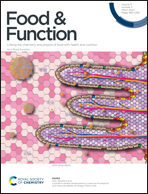 “The growing concern on the antibiotic resistance spreading among bacteria has stimulated the search for valuable alternatives from plant sources.
“The growing concern on the antibiotic resistance spreading among bacteria has stimulated the search for valuable alternatives from plant sources.
This study dealt with the potential use of hemp (Cannabis sativa L.) seeds extract to inhibit the growth of selected pathogenic enterobacteria and the biofilm formation by Staphylococcus aureus, representing severe risks of food-borne illnesses. Effects on probiotic bacteria were also examined. A double-staining viability/mortality assay was used to examine potential S. aureus membrane damage.
Our results highlighted a selective antimicrobial activity of C. sativa extract against pathogenic strains and no inhibitory effects on the growth of probiotic strains belonging to the Bifidobacterium and Lactobacillus genera. This selective inhibition is of outmost importance for the maintenance of healthy gut microbiota.
The double-staining assay showed that the C. sativa extract was capable of inhibiting the biofilm producer S. aureus ATCC 35556 strain; this antibacterial action was only partially linked to membrane damage. Biofilm formation was inhibited as well; inhibition occurs at lower concentration with respect to planktonic cells (0.5 mg/ml vs 1 mg/ml, respectively).
Therefore, hemp seeds extracts represent a new exploitable and valuable antimicrobial and antibiofilm agent for the food and nutraceutical industry as a possible alternative to antibiotics/antibacterial compounds.
•Cannabis sativa L. seeds showed antimicrobial and antibiofilm activity.
•C. sativa L. seeds selectively inhibit the growth of potentially pathogenic strains.
•C. sativa L. seeds did not exert antimicrobial activity against probiotic bacteria.
•C. sativa L. seeds inhibit the biofilm formation by Staphylococcus aureus.”
https://www.sciencedirect.com/science/article/pii/S0023643820301377

“Antimicrobial Activity of Cannabis sativa L.” https://www.scirp.org/journal/PaperInformation.aspx?PaperID=18123

 “Inflammatory bowel diseases (IBD) are characterized by a chronic and recurrent gastrointestinal condition, including mainly ulcerative colitis (UC) and Crohn’s disease (CD). Cannabis sativa (CS) is widely used for medicinal, recreational, and religious purposes. The most studied compound of CS is tetrahydrocannabinol (THC) and
“Inflammatory bowel diseases (IBD) are characterized by a chronic and recurrent gastrointestinal condition, including mainly ulcerative colitis (UC) and Crohn’s disease (CD). Cannabis sativa (CS) is widely used for medicinal, recreational, and religious purposes. The most studied compound of CS is tetrahydrocannabinol (THC) and  “Hempseed (Cannabis sativa L.) has beneficial impact on human health mainly because of its wide variability of bioactive compounds. However, many of them are not fully characterized yet. In this work, hempseed was defatted and through a bio-guided studied, two fractions (F03 and F05) with the highest content of phenols, flavonoids and antioxidant capacity were selected. Fractions were chemically analyzed by UHPLC HRMS/MS. The anti-inflammatory capacities of these compounds were evaluated on human monocytes using flow cytometry, RT-qPCR and Elisa procedures. A high amount of phenolic compounds were identified, with the major compound being: N-trans-caffeoyltyramine (6.36 mg g-1 in F05 and 1.28 mg g-1 in F03). Both, F03 and F05 significantly reduced the inflammatory competence of LPS-treated human primary monocytes, decreasing TNF-α and IL-6 gene expression and secretion. These findings indicate that in the defatted fraction of the hempseed there are a wide number of compounds with beneficial potential to prevent and treat inflammatory disorders, as well as other processes caused by oxidative stress.”
“Hempseed (Cannabis sativa L.) has beneficial impact on human health mainly because of its wide variability of bioactive compounds. However, many of them are not fully characterized yet. In this work, hempseed was defatted and through a bio-guided studied, two fractions (F03 and F05) with the highest content of phenols, flavonoids and antioxidant capacity were selected. Fractions were chemically analyzed by UHPLC HRMS/MS. The anti-inflammatory capacities of these compounds were evaluated on human monocytes using flow cytometry, RT-qPCR and Elisa procedures. A high amount of phenolic compounds were identified, with the major compound being: N-trans-caffeoyltyramine (6.36 mg g-1 in F05 and 1.28 mg g-1 in F03). Both, F03 and F05 significantly reduced the inflammatory competence of LPS-treated human primary monocytes, decreasing TNF-α and IL-6 gene expression and secretion. These findings indicate that in the defatted fraction of the hempseed there are a wide number of compounds with beneficial potential to prevent and treat inflammatory disorders, as well as other processes caused by oxidative stress.” “Hemp (Cannabis sativa L.) has become widely used in several sectors due to the presence of various bioactive compounds such as terpenes and
“Hemp (Cannabis sativa L.) has become widely used in several sectors due to the presence of various bioactive compounds such as terpenes and  “Cannabis use in the management of musculoskeletal diseases has gained advocacy since several states have legalized its recreational use.
“Cannabis use in the management of musculoskeletal diseases has gained advocacy since several states have legalized its recreational use. “The societal burden of ischemic stroke suggests a need for additional therapeutic categories in stroke prevention.
“The societal burden of ischemic stroke suggests a need for additional therapeutic categories in stroke prevention. “This preliminary study examines whether daily CBD dose of 15-25 mg/kg produces cerebral macrostructure changes and, if present, how they relate to changes in seizure frequency.
“This preliminary study examines whether daily CBD dose of 15-25 mg/kg produces cerebral macrostructure changes and, if present, how they relate to changes in seizure frequency.